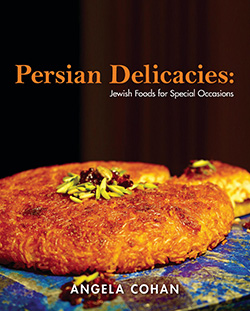Persian Delicacies: Jewish Foods for Special Occasions by Angela Cohan; Portland, Oregon: Overcup Press (c) 2021; ISBN 9781732-610347; 248 pages, with over 100 recipes and dozens of full-color photos, $35.
By Danielle Levsky

 SAN DIEGO — Angela Cohan wrote Persian Delicacies: Jewish Foods for Special Occasions to explore what food has meant to her family and to her heritage. “Food is nourishment. Food is medicine. Food is love,” she writes in the preface to the cookbook. What ensues is a vibrant collection of recipes that have fed her family in Southern California and in Iran prior to the Iranian Revolution of 1979.
SAN DIEGO — Angela Cohan wrote Persian Delicacies: Jewish Foods for Special Occasions to explore what food has meant to her family and to her heritage. “Food is nourishment. Food is medicine. Food is love,” she writes in the preface to the cookbook. What ensues is a vibrant collection of recipes that have fed her family in Southern California and in Iran prior to the Iranian Revolution of 1979.
In each recipe, Cohan lightly hints to the origin story of the recipe, be it a family tradition or common practice among Persian and/or Jewish families. As a reader, I was hungry to learn more about the significance and symbolism behind many of the dishes presented. Certain dishes received ample airtime (Tahdig), and others did not (Joojeh Bademjam). Why, for instance, did more of the traditional recipes call for meat, olive oil, gluten products, etc.? What in Persian and/or Jewish history, land, region, etc. influence the ingredients with which these dishes were prepared?
Cohan also includes recipes her family has enjoyed and picked up since immigrating to Southern California and learning from other families and friends in the region, including recipes from Almond Milk, Olovieh Salad, Pumpkin Soup, Paneer, and more. Again, I was eager to learn more about how these recipes influenced her and her family, what other cultural traditions they learned from, and how they may have incorporated traditional Persian-Jewish ingredients into the new dishes they learned about. For instance, Olovieh Salad is a traditional Russian/Post-Soviet salad dish that has travelled throughout the Eastern Bloc, and into other parts of Central Europe, Central Asia, and more. It would be interesting to know how her family came to know, and adapt, this recipe.
Still, the ingredients and directions for each recipe were clearly written and explained. From more challenging recipes to more simple ones, Cohan was able to synthesize her directions for cooking with clarity and precision. In the introduction to the book, Cohan emphasized a focus on dietary restrictions and replacements in the book’s recipes. This provided plenty of options for the reader to adapt recipes to their home’s liking. One area in which I would have loved more clarity would have been preparation of certain ingredients. For instance, for Maast-o-Khiar and Maast-o-Moosir, the recipe instructions dictated that you could cube, grate, or slice an ingredient. As these all create different texture effects, I was curious as to which method would be best as I prepared my dishes.
Readers will find a great introduction to traditional Persian-Jewish recipes as well as current American recipes, with modifications for dietary restrictions provided; a great touch for the modern reader and home chef. Each recipe is highlighted with a gorgeously framed picture. There is also a lovely index at the close of the dessert pages that list the holidays she and her family celebrate. Ultimately, this cookbook would be better served with a side of more story, more background, and more context.
*
Danielle Levsky (she/her) is an arts and culture writer, clown, producer, and educator based in San Diego whose work features people, ideas, and principles that highlight the experiences of diverse audiences.